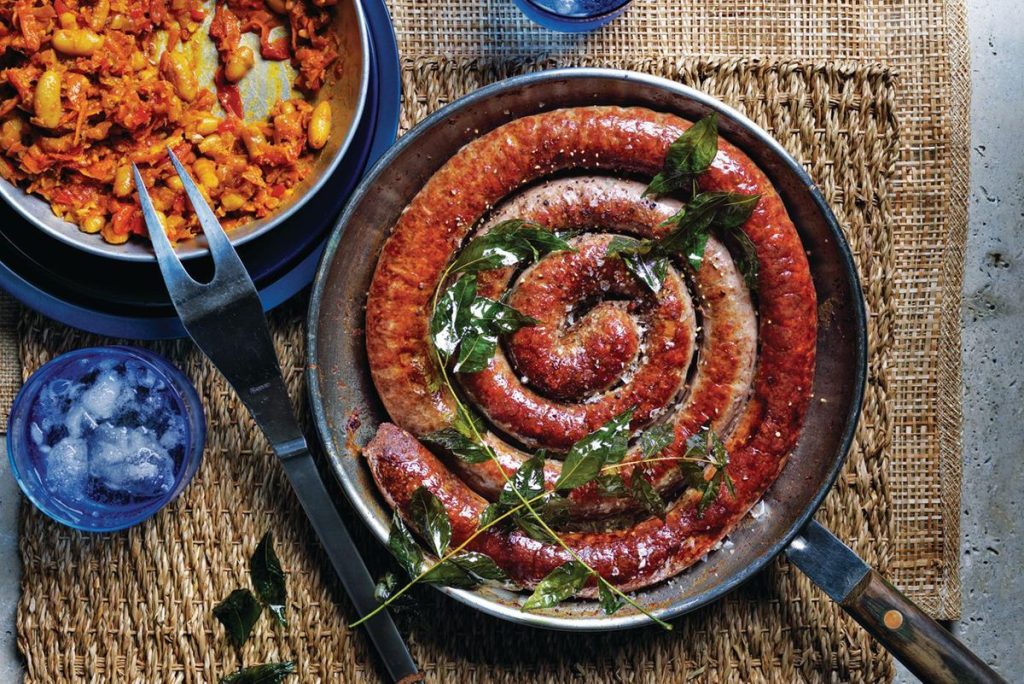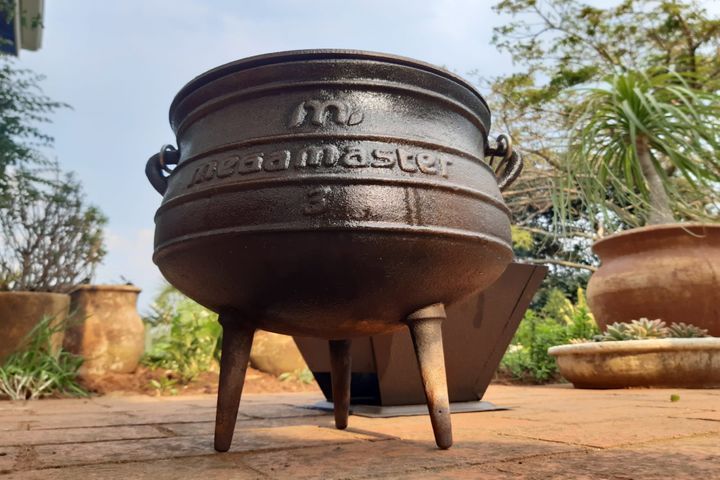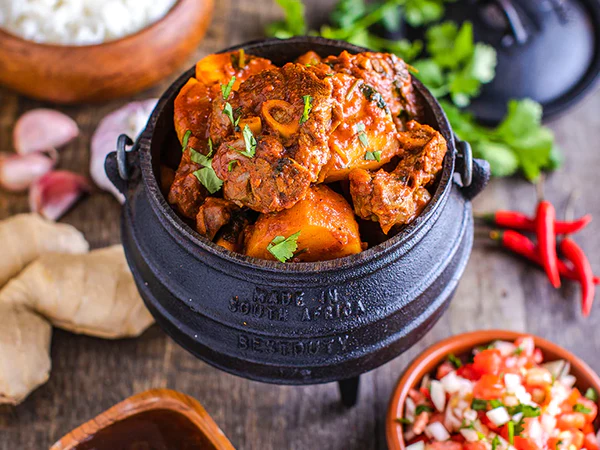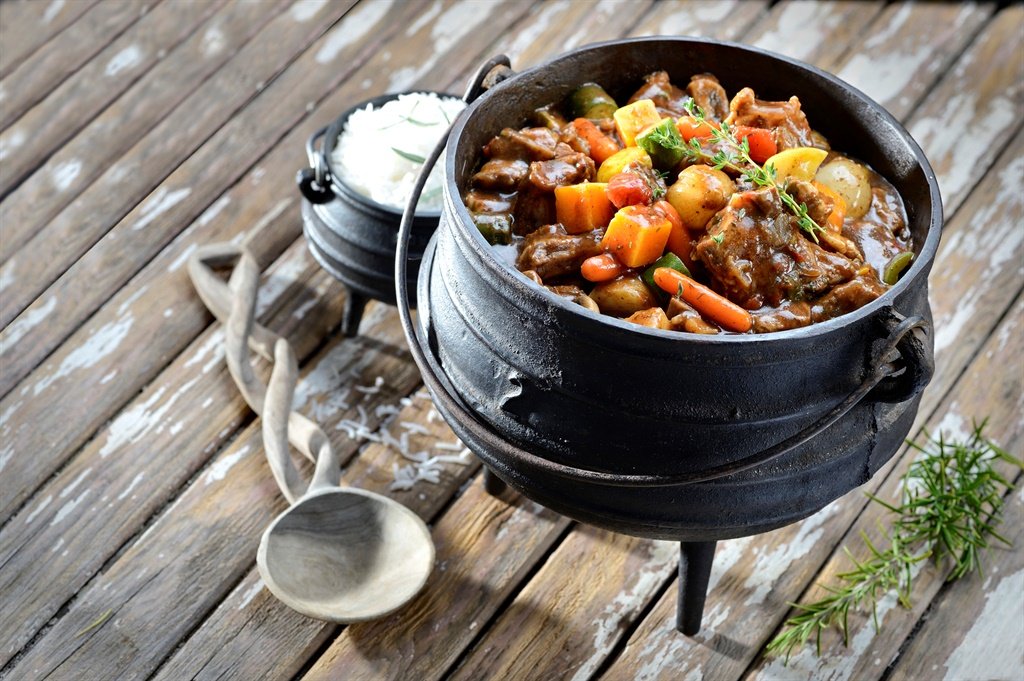Delight in South African Cuisine: Boerewors, Potjiekos, and Bobotie
Boerewors, often referred to as “Farmer’s Sausage,” is a traditional South African sausage that holds significant cultural and culinary importance. This flavorful sausage is a staple in South African cuisine, enjoyed at barbecues (braais), social gatherings, and family meals. The name “boerewors” is derived from the Afrikaans and Dutch words “boer” (farmer) and “wors” (sausage).
South Africans classify the quality of a butcher by the quality of their boerewors. Although these look like plain sausage to visitors, butchers in South Africa are familiar with the strict rules governing the making of this authentic delicacy.
- The sausage should contain at least 90% meat or fat from beef, pork, lamb or goat.
- The meat blend must always be a majority of roughly ground beef. Pork and lamb may be added for flavor and consistency.
- The meat must not contain more than 30% fat.

Boerewors Recipe:
Ingredients:
- 2 pounds beef (typically a mix of lean and fatty cuts)
- 1 pound pork (shoulder or belly)
- 1 large onion, finely chopped
- 2 teaspoons salt
- 1 teaspoon black pepper
- 1 teaspoon coriander seeds, crushed
- 1 teaspoon nutmeg, ground
- 1 teaspoon allspice, ground
- 1 teaspoon dried thyme
- 1 tablespoon brown sugar
- 1 tablespoon vinegar (malt or wine vinegar)
- Sausage casings (usually natural hog casings)
Instructions:
- Prepare Meat:
- Cut the beef and pork into small pieces suitable for grinding.
- Grind Meat:
- Using a meat grinder, grind the beef and pork. Ensure a good balance of lean and fatty meat for flavor and moisture.
- Mix Ingredients:
- In a large bowl, mix the ground meat with chopped onion, salt, black pepper, crushed coriander seeds, nutmeg, allspice, dried thyme, brown sugar, and vinegar. Mix thoroughly to distribute the spices evenly.
- Soak Sausage Casings:
- If using natural hog casings, soak them in water according to package instructions.
- Stuff Casings:
- Stuff the meat mixture into the sausage casings, forming a long coil. Be careful not to overstuff to prevent bursting during cooking.
- Twist and Link:
- Twist the sausages at regular intervals to create individual links.
- Braai (Barbecue):
- Boerewors is traditionally cooked on a braai (barbecue) or grill. Cook over medium heat until the sausages are browned and cooked through, turning them regularly.
- Serve:
- Serve boerewors hot off the grill. It’s often enjoyed with sides like fresh bread, chutney, or a tomato-based relish.

Cultural Significance:
- Braai Tradition: Boerewors is an integral part of South Africa’s braai (barbecue) culture. It’s a popular choice for outdoor gatherings and celebrations.
- Heritage and Identity: Boerewors reflects the diverse culinary heritage of South Africa, with its roots in Afrikaans and Dutch traditions.
- National Dish: Considered by many as a national dish, boerewors is celebrated for its unique flavor profile and cultural significance.
Boerewors is more than just a sausage; it’s a symbol of South African culinary identity, bringing people together around the grill to share in the joy of good food and community.
The Savoring Taste of Potjiekos – A South African Indigenous Dish
Potjiekos, meaning “small pot food,” refers to a traditional South African dish cooked in a cast-iron pot called a “potjie.” The potjie pot itself is often referred to as “potjie” as well. Typically, potjiekos consists of meat and vegetables and is cooked slowly over an open fire outdoors.
The key rule when cooking with a potjie pot is not to stir it during the cooking process. This method allows the ingredients to cook perfectly without overly blending flavors, ensuring that each mouthful offers a unique combination of tastes and textures. Unlike a stew, where ingredients may become indistinguishable, potjiekos allows you to visually identify each component. Additionally, cooking over an open flame imparts a distinct smoky flavor to the dish, further enhancing its appeal.
The potjie pot has its origins in the Netherlands and was brought to South Africa in the 17th century. Similar to the Dutch oven, which is popular in the United States and elsewhere, the potjie pot is a three-legged cauldron.

Potjie pots are available in various sizes, and while some people cook directly over hot coals, others use safer potjie stands resembling pyramid-shaped fire pits.
Before using a potjie pot for cooking, it’s essential to prepare it properly to prevent rusting and ensure the quality of the food. This involves curing the pot by coating the inside with cooking oil and heating it until the oil begins to smoke. This process is repeated until the pot is fully seasoned. After cooking, the potjie pot can be washed with water, reserving the use of soap for future cleaning.
Potjiekos Cooking Method:
Ingredients:
- Meat (common choices include beef, lamb, or game meat)
- Fresh vegetables (such as potatoes, carrots, onions, and tomatoes)
- Sauce or broth
- Spices and herbs
- Cooking fat (such as oil or butter)
Instructions:
- Layering Ingredients:
- Start by layering the bottom of the cast-iron pot with cooking fat. Add the meat as the first layer, followed by vegetables.
- Adding Sauce and Seasoning:
- Pour a sauce or broth over the layers. The choice of sauce can vary, from a simple tomato-based sauce to a more complex blend of spices and herbs.
- Slow-Cooking on Low Heat:

- Place the pot over a low heat source, often an open fire. The slow-cooking process allows the flavors to meld and intensify. The cast-iron pot retains and distributes heat evenly.
- Controlling Heat:
- Controlling the fire heat is crucial. Indigenous South Africans often learn this art from an early age, knowing how to adjust the heat to achieve the desired slow-cooking effect. This skill is often passed down through generations.
- Stirring and Checking:
- Occasionally stir the ingredients to ensure even cooking. Check the tenderness of the meat and doneness of the vegetables.
- Serving:
- Once the meat is tender, and the flavors have melded, the potjiekos is ready to be served. The result is a flavorful and hearty stew with layers of meat and vegetables.

Cultural Significance:
- Social Gatherings: Potjiekos is often associated with social gatherings and outdoor events. It brings people together around the fire, creating a communal and festive atmosphere.
- Culinary Creativity: The layered cooking method allows for creativity in combining flavors and textures. Different regions and communities may have their variations of potjiekos recipes.
- Heritage and Tradition: Cooking potjiekos is a cultural tradition that has been passed down through generations, reflecting the diverse culinary heritage of South Africa.
Potjiekos is more than just a cooking method; it’s a cultural experience that embodies the essence of community, tradition, and the art of slow-cooked flavors.
Bobotie – A South African Minced Meat Delicacy
Bobotie, a traditional South African dish, shares similarities with patinam ex lacte, a dish documented by the ancient Roman writer Apicius. Patinam ex lacte consisted of layers of cooked meat, pine nuts, and seasoning, topped with a mixture of egg and milk before being cooked until set. This dish was known in Europe in the seventeenth century, according to C. Louis Leipoldt, a South African writer and gourmet.
The origin of the word “bobotie” is debated. The Afrikaans etymological dictionary suggests that it may come from the Malayan word “boemboe,” meaning curry spices. Others speculate that it originated from “bobotok,” an Indonesian dish with different ingredients. The first recorded recipe for bobotie appeared in a Dutch cookbook in 1609. The dish was later introduced to South Africa and adopted by the Cape Malay community, where it became a staple.
Bobotie typically includes curry powder, giving it a subtle tangy flavor, and is often served with sambal. It has been part of South African cuisine since the 17th century, initially made with a mixture of mutton and pork. Over time, variations of bobotie have emerged, with different meats and flavorings being used based on regional preferences.
The dish has evolved over the centuries, blending various cultural influences to become the beloved recipe it is today.

Bobotie Recipe:
Ingredients:
For the Minced Meat Mixture:
- Ground beef or lamb
- Medium-hot curry powder
- Turmeric
- Garlic, minced
- Lemon zest
- Onions, finely chopped
- Mixed herbs
- Salt and pepper to taste
- Raisins (optional)
For the Topping:
- Eggs
- Milk
For Serving:
- Yellow rice (long-grain white rice cooked with turmeric and raisins)
- Apricot fruit chutney
Instructions:
- Prepare Minced Meat Mixture:
- Combine ground meat with curry powder, turmeric, minced garlic, lemon zest, chopped onions, mixed herbs, salt, and pepper. Add raisins if desired.
- Bake Minced Meat:
- Place the seasoned minced meat mixture in a baking dish and bake until fully cooked.
- Prepare Custard Topping:
- Whisk together eggs and milk to create a custard-like mixture.
- Top and Bake Again:
- Pour the egg and milk mixture over the cooked minced meat. Bake until the custard layer sets.
- Serve:
- Cut the baked bobotie into squares and serve on a bed of yellow rice. Optionally, serve with melted apricot fruit chutney on the side.
Origins of Bobotie:
- Roman Influence: A dish with layers of meat and spices similar to bobotie was described by the Roman writer Apicius in ancient times.
- Dutch Arrival in South Africa (1609): The Dutch recorded a bobotie recipe in 1609 and brought it to South Africa during the colonial period.
- Cape Malay Influence: Over time, the Cape Malay community in South Africa spiced up the dish, adding their own unique flavors and creating the modern bobotie.
Bobotie represents a beautiful fusion of culinary traditions, showcasing the diverse influences that have shaped South African cuisine over the centuries. It has become a staple dish, celebrated for its bold flavors and cultural significance.
Add a Comment
You must be logged in to post a comment.

